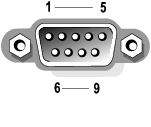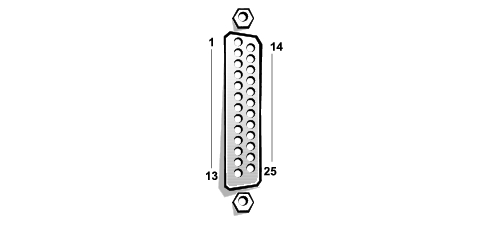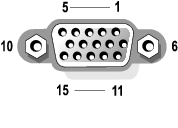 I/O Ports and Connectors
I/O Ports and ConnectorsDell™ PowerEdge™ 600SC Systems User's Guide
 Serial and Parallel Connectors
Serial and Parallel Connectors
 Integrated Network Interface Controller Connector
Integrated Network Interface Controller Connector
The I/O ports and connectors on the back panel of the system are the gateways through which the system communicates with external devices, such as a keyboard, mouse, printer, and monitor. Figure B-1 identifies the I/O ports and connectors for your system.
Figure B-1. I/O Ports and Connectors

The integrated serial connector uses a 9-pin D-subminiature connector on the back panel. This connector supports devices such as external modems, printers, plotters, and mice that require serial data transmission (the transmission of data one bit at a time over one line).
Most software uses the term COM (for communications) plus a number to designate a serial connector (for example, COM1). The default designation of your system's integrated serial connector is COM1.
The integrated parallel connector uses a 25-pin D-subminiature connector on the system's back panel. This I/O port sends data in parallel format (where eight data bits, or one byte, are sent simultaneously over eight separate lines in a single cable). The parallel connector is used primarily for printers.
Most software uses the term LPT (for line printer) plus a number to designate a parallel connector (for example, LPT1). The default designation of the system's integrated parallel connector is LPT1.
Port designations are used, for example, in software installation procedures that include a step in which you identify the connector to which a printer is attached, thus telling the software where to send its output. (An incorrect designation prevents the printer from printing or causes scrambled print.)
The system has an autoconfiguration capability for the serial connector. This feature lets you add an expansion card containing a serial connector that has the same designation as the integrated connector, without having to reconfigure the card. When the system detects the duplicate serial connector on the expansion card, it remaps (reassigns) the integrated connector to the next available designation.
Both the new and the remapped COM connectors share the same interrupt request (IRQ) setting, as follows:
These COM ports have the following I/O address settings:
For example, if you add an internal modem card with a port configured as COM1, the system then sees logical COM1 as the address on the modem card. It automatically remaps the integrated serial connector that was designated as COM1 to COM3, which shares the COM1 IRQ setting. (Note that when you have two COM ports sharing an IRQ setting, you can use either port as necessary but you may not be able to use them both at the same time.) If you install one or more expansion cards with serial connectors designated as COM1 and COM3, the integrated serial connector is disabled.
Before adding a card that remaps the COM ports, check the documentation that accompanied the software to make sure that the software can be mapped to the new COM port designation.
To avoid autoconfiguration, you may be able to reset jumpers on the expansion card so that the card's port designation changes to the next available COM number, leaving the designation for the integrated connector as is. Alternatively, you can disable the integrated connector through the System Setup program. The documentation for your expansion card should provide the card's default I/O address and allowable IRQ settings. It should also provide instructions for readdressing the connector and changing the IRQ setting, if necessary.
If you add an expansion card containing, for example a parallel connector configured as LPT1 (IRQ7, I/O address 378h), you must go into the System Setup program to remap the integrated parallel connector.
For general information on how your operating system handles serial and parallel ports, and for more detailed command procedures, see your operating system documentation.
If you reconfigure your hardware, you may need pin number and signal information for the serial connector. Figure B-2 illustrates the pin numbers for the serial connector and Table B-1 defines the pin assignments and interface signals for the serial connector.
Figure B-2. Serial Connector Pin Numbers

|
Pin |
Signal |
I/O |
Definition |
|---|---|---|---|
1 | DCD | I | Data carrier detect |
2 | SIN | I | Serial input |
3 | SOUT | O | Serial output |
4 | DTR | O | Data terminal ready |
5 | GND | N/A | Signal ground |
6 | DSR | I | Data set ready |
7 | RTS | O | Request to send |
8 | CTS | I | Clear to send |
9 | RI | I | Ring indicator |
Shell | N/A | N/A | Chassis ground |
If you reconfigure your hardware, you may need pin number and signal information for the parallel connector. Figure B-3 illustrates the pin numbers for the parallel connector and Table B-2 defines the pin assignments and interface signals for the parallel connector.
Figure B-3. Parallel Connector Pin Numbers

|
Pin |
Signal |
I/O |
Definition |
|---|---|---|---|
1 | STB# | I/O | Strobe |
2 | PD0 | I/O | Printer data bit 0 |
3 | PD1 | I/O | Printer data bit 1 |
4 | PD2 | I/O | Printer data bit 2 |
5 | PD3 | I/O | Printer data bit 3 |
6 | PD4 | I/O | Printer data bit 4 |
7 | PD5 | I/O | Printer data bit 5 |
8 | PD6 | I/O | Printer data bit 6 |
9 | PD7 | I/O | Printer data bit 7 |
10 | ACK# | I | Acknowledge |
11 | BUSY | I | Busy |
12 | PE | I | Paper end |
13 | SLCT | I | Select |
14 | AFD# | O | Automatic feed |
15 | ERR# | I | Error |
16 | INIT# | O | Initialize printer |
17 | SLIN# | O | Select in |
18–25 | GND | N/A | Signal ground |
The system supports a PS/2-compatible keyboard and mouse. Cables from both devices attach to 6-pin, miniature Deutsche Industrie Norm (DIN) connectors on the back panel of the system.
Mouse driver software can give the mouse priority with the microprocessor by issuing IRQ12 whenever a new mouse movement is detected. The driver software also passes along the mouse data to the application program that is in control.
If you reconfigure your hardware, you may need pin number and signal information for the keyboard connector or mouse connector. Figure B-4 illustrates the pin numbers for the keyboard and mouse connectors and Table B-3 defines the pin assignments and interface signals for the keyboard and mouse connectors.
Figure B-4. Keyboard and Mouse Connector Pin Numbers

Table B-3. Keyboard and Mouse Connector Pin Assignments Pin Signal I/O Definition 1 KBDATA or MFDATA I/O Keyboard data or mouse data 2 NC N/A No connection 3 GND N/A Signal ground 4 FVcc N/A Fused supply voltage 5 KBCLK or MFCLK I/O Keyboard clock or mouse clock 6 NC N/A No connection Shell N/A N/A Chassis ground
The system uses a 15-pin high-density D-subminiature connector on the back panel for attaching a video graphics array (VGA)-compatible monitor to the system. The video circuitry on the system board synchronizes the signals that drive the red, green, and blue electron guns in the monitor.
 |
NOTE: Installing a video card automatically disables the system's integrated video subsystem. |
If you reconfigure your hardware, you may need pin number and signal information for the video connector. Figure B-5 illustrates the pin numbers for the video connector, and Table B-4 defines the pin assignments and interface signals for the video connector.
Figure B-5. Video Connector Pin Numbers

Table B-4. Video Connector Pin Assignments Pin Signal I/O Definition 1 RED O Red video 2 GREEN O Green video 3 BLUE O Blue video 4 NC N/A No connection 5–8, 10 GND N/A Signal ground 9 VCC N/A Vcc 11 NC N/A No connection 12 DDC data out O Monitor detect data 13 HSYNC O Horizontal synchronization 14 VSYNC O Vertical synchronization
Your system contains two USB connectors for attaching USB-compliant devices. USB devices are typically peripherals such as mice, printers, keyboards, and system speakers.
 |
NOTICE: Do not attach a USB device or a combination of USB devices that draw a maximum current over 500 milliamperes (mA) per channel or +5 volts (V). Attaching devices that exceed this threshold may cause the USB ports to shut down. See the documentation that accompanied the USB devices for their maximum current ratings. |
If you reconfigure your hardware, you may need pin number and signal information for the USB connectors. Figure B-6 illustrates the pin numbers for the USB connectors and Table B-5 defines the pin assignments and interface signals for the USB connectors.
Figure B-6. USB Connector Pin Numbers

Table B-5. USB Connector Pin Assignments Pin Signal I/O Definition 1 Vcc N/A Supply voltage 2 DATA I Data in 3 +DATA O Data out 4 GND N/A Signal ground
Your system has an integrated 10/100/1000-megabit-per-second (Mbps) network interface controller (NIC). The NIC provides all the functions of a separate network expansion card while providing fast communication between servers and workstations and efficient utilization of host resources, freeing more of the system resources for other applications. The NIC supports 10 Base-T, 100 Base-TX, and 1000 Base-T Ethernet standards.

Your system's RJ45 NIC connector is designed for attaching an unshielded twisted pair (UTP) Ethernet cable equipped with a standard RJ45-compatible plug. Press one end of the UTP cable into the NIC connector until the plug snaps securely into place. Connect the other end of the cable to an RJ45 jack wall plate or to an RJ45 port on a UTP concentrator or hub, depending on your network configuration. Observe the following cabling restrictions for 10 Base-T, 100 Base-TX, and 1000 Base-T networks.
 |
NOTICE: To avoid line interference, voice and data lines must be in separate sheaths. |